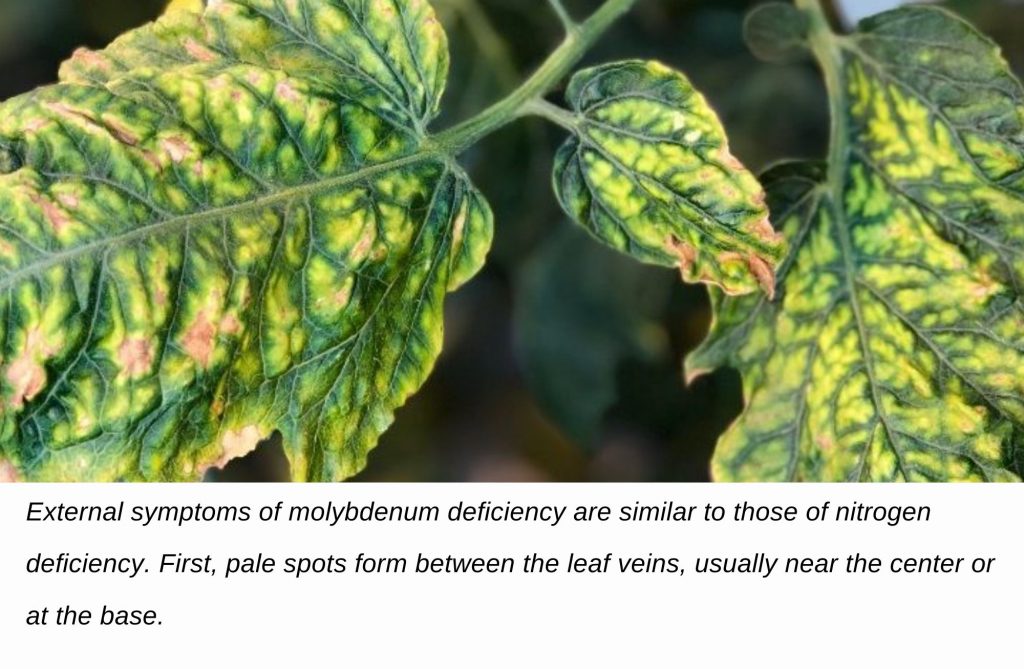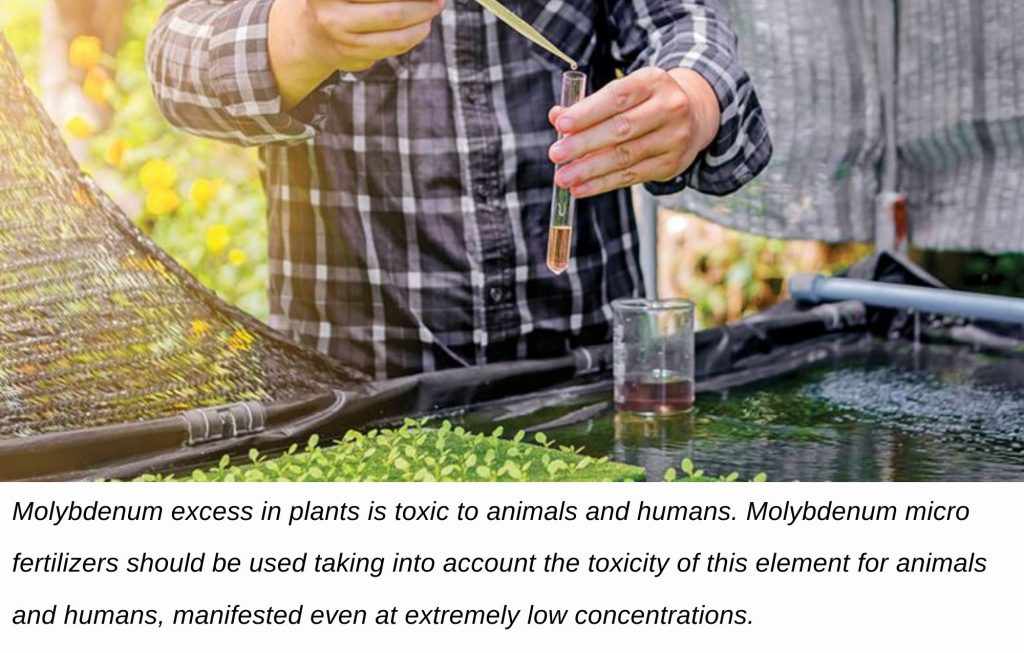Each plant requires certain chemical elements for its growth and development. The crops’ need for micronutrients is quite small. However, their effect on growth is obvious and indisputable and their deficiency can affect the yield and quality of the crop. Micronutrients take a very active part in many life processes occurring in plants at the molecular level. To adjust the content of trace elements in the soil they practice foliar feeding during the growing season and the introduction of necessary substances into the soil in the form of fertilizers.

Molybdenum in nature
Under natural conditions, this micronutrient occurs as the metal molybdenite or in mineral form (MoS2).
Molybdenum content in different soil types
In soils, this micronutrient can be found in the following forms:
- in the crystalline lattice of minerals (inaccessible to plants);
- in the form of MoO4 anion absorbed by clay minerals and colloidal iron and aluminum oxides (conditionally available to plants);
- as a part of organic matter (available to plants only after mineralization);
- in the form of water-soluble molybdenum.
The content of this microelement in soils is usually close to the concentration in the parent rock and in the soils of the world varies between 0.013-17 mg/kg. Soils formed on granite rocks and organically enriched shales contain higher amounts of molybdenum. Unlike other metals, molybdenum is less soluble in acidic soils and easily mobile in alkaline soils.
The highest content in chernozemic soils is on average 4.6 mg/kg. Saline soils are the poorest (0.95 mg/kg), chestnut soils are a little richer (1.1 mg/kg) and gray soils (1.3 mg/kg). Red soils, podzols, and bog soils are in the middle position in terms of molybdenum content. The content of the metal in rocks varies considerably: from 0.5 to 12, 0 mg/kg
In addition, the molybdenum content depends on the mechanical composition of soils. Samples with a light texture, sandy, and sandy loam, are the poorest. Clayey and loamy soils, as a rule, are richer. Fertile cultivated soils are characterized by a higher content of this element than uncultivated ones. Soils formed on serpentinites are also characterized by the low content of this micronutrient.

Role of molybdenum in plants
This essential micronutrient is part of a few plant proteins. It enters plants in the form of the Mo2-4 anion and is concentrated in growing young organisms. Legumes contain the greatest amount of it, with more in the leaves than in the roots and stems. In leaf laminae, molybdenum is concentrated in chloroplasts.
Molybdenum is also present in other enzymes (oxidases) that accelerate a variety of unrelated reactions. The main enzymatic role of this micronutrient is directly related to the function of electron transfer.
Just like iron, this micronutrient is necessary for the synthesis of light hemoglobin (the protein that carries oxygen in nodules). Its deficiency causes the color of nodules to change to yellow or gray (the normal color is red). There are more than 20 known molybdenum-containing enzymes. Among them are aldehyde oxidase (catalyzes the conversion of abscisic aldehyde to the phytohormone abscisic acid), sulfitoxylase (oxidizes SO2-3 to SO2-4), xanthine dehydrogenase, and others. In all the enzymes above, the micronutrient is present in the form of molybdopterin, which provides molybdenum resistance to oxidation.
Molybdenum deficiency in plants
Symptoms of the deficiency appear in plants in acidic mineral soils with high content of manganese and iron hydroxides. The presence of sulfate anions competing with molybdate anions in the soil solution causes the deficiency to worsen. The critical level of molybdenum content in plants ranges from 0.1 to 1 mg/kg of leaf dry weight.
Changes in the internal structure
When molybdenum is deficient, the epidermis shrinks, and the leaf structure changes. Before the changes become visually visible, the size of chloroplasts decreases in young leaves. As chlorosis progresses, chloroplasts swell at the expense of starch grains. In a situation of further molybdenum deficiency, chloroplasts disintegrate into a diffuse mass negative for protein, lipids, and RNA. Chloroplast lysis occurs, starch grains shrivel up and dissolve outside the newly formed structures. With molybdenum deficiency, plants become intolerant to low temperatures and water deficiency. There are also abnormalities in pollen formation.
External signs
External symptoms of molybdenum deficiency are similar to those of nitrogen deficiency. First, pale spots form between the leaf veins, usually near the center or at the base. Numerous perforations appear on the affected areas. Later, areas affected by chlorosis and necrosis form irregularities and tears at the periphery of the leaf blade. For example, in cabbage, leaf spotting is accompanied by wilting of leaf margins, while in tomato and potato the leaf blades curl.
Molybdenum deficiency also negatively affects flower formation. In tomatoes, they grow smaller, almost sit on the stem and do not open, and in cauliflower, they are deformed and become loose. In legumes, the lack of this element impairs the formation of nodules on the roots.
Molybdenum excess
Phytotoxicity of this micronutrient appears only at very high concentrations. For example, signs of molybdenum poisoning of young barley seedlings were noted at Mo content of 135 mg/kg dry weight.
Symptoms of toxicity are similar to deficiency, and the more obvious symptoms of toxicity are actually the signs of other nutrient deficiencies because high levels of this micronutrient can reduce uptake of other nutrients, particularly copper. If molybdenum toxicity is ever suspected, sulfur applications can reduce molybdenum uptake until soil levels drop, and especially if soil pH is greater than 7. Care must be taken to prevent other nutrient imbalances. Under such conditions, molybdenum-containing fertilizers should not be used.
Molybdenum excess in plants is toxic to animals and humans. Molybdenum micro fertilizers should be used taking into account the toxicity of this element for animals and humans, manifested even at extremely low concentrations. This is especially characteristic of forage plants.
Conclusion
Although the requirement for molybdenum in crops is relatively low, it plays an important role in their growth and development processes. The introduction of fertilizers containing this micronutrient can significantly impact your plants’ growth and yields.


